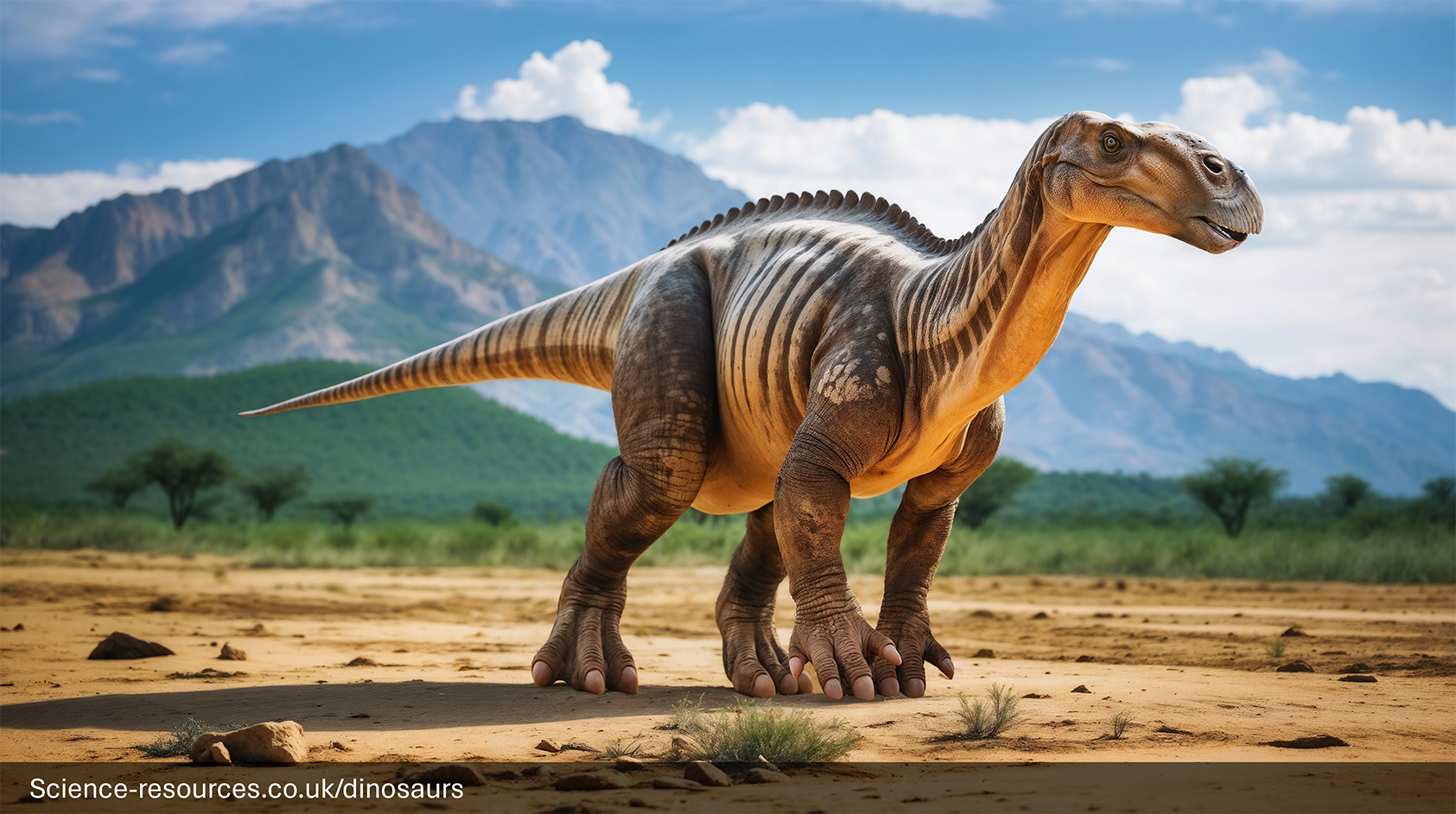Dinosaurs A:Z | I
You may also be intrested in: Free Dinosaur games
Dinosaurs: Iguanodon (Iguana Tooth)
You may also be intrested in: Free Dinosaur games
Iguanodon was a large plant-eating dinosaur that lived during the Early Cretaceous period, about 140 to 110 million years ago. It is one of the most well-known and widespread dinosaurs, recognised by its size and unique thumb spikes. Length: Iguanodon could grow up to 9 meters (30 feet) long. Weight: They weighed around 4 to 5 tons, about the same as a modern-day elephant. Iguanodon had a distinctive look with its unique thumb spikes, which were likely used for defense. It stood nearly 2 meters tall at the hip and could walk on both two and four legs. Its five-fingered hands had one spike-like thumb and three middle fingers with blunt, hoof-like claws. The fifth finger was flexible and could move sideways. Generative AI Notification: Some elements of this image have been created or enhanced using AI technology. To find out how we create all our dinosaurs, click here.
Iguanodon was a herbivore, meaning it only ate plants. It had ridged teeth and a horned beak, which helped it chew tough plant material like low-growing ferns and horsetails. Fossils of Iguanodon have been found in Europe, North Africa, North America, Australia, and Asia. They lived in areas near streams and rivers, which provided plenty of plants for them to eat. • Iguanodon was the second dinosaur to be scientifically described, right after Megalosaurus. • Its name means "Iguana Tooth" because its teeth resemble those of modern iguanas. • Early reconstructions mistakenly placed Iguanodon in a kangaroo-like stance with its tail on the ground, which was corrected later to a more accurate horizontal posture. What is an Iguanodon?
How big was Iguanodon?
Appearance
 Iguanodon
IguanodonWhat did Iguanodon eat?
Where did Iguanodon live?
Interesting facts
Pronounced: ig


Iguanodon Facts
Name Means: "Iguana Tooth"
Length: 40 feet (12 m)
Height: 12 feet (3.6 m)
Weight: 5 ton (4,500 kg)
Diet: Herbivore (Leaves,
Branches, Fronds, Ferns)
Time: Early Cretaceous - 110 million years ago
Habitat: Woodlands
Fossils Found: Asia, Europe, North Africa, Western North America
Iguanodon belonged to a family of dinosaurs called Iguanodontids, which are closely related to hadrosaurs or duck-billed dinosaurs.
Iguanodon could move on both two and four legs, likely walking on four legs while grazing and standing on two legs when it needed to reach higher plants or move quickly.
The thumb spikes of Iguanodon were likely used for defense against predators. Its flexible fifth finger could have been used to manipulate food or objects. The movable joints in its skull and jaws allowed it to chew tough plant material efficiently.
Q1: What is an Iguanodon?
A1: Iguanodon was a large, herbivorous dinosaur that lived during the Early Cretaceous period, around 125 to 113 million years ago. It is known for its thumb spikes and beak-like mouth.
Q2: How big was the Iguanodon?
A2: Iguanodon could grow up to 10 meters (33 feet) long and weigh around 3.5 metric tons (7,700 pounds).
Q3: What did Iguanodon eat?
A3: Iguanodon was a herbivore, meaning it ate plants. It likely fed on a variety of vegetation, including ferns, cycads, and conifers.
Q4: How did Iguanodon move?
A4: Iguanodon could walk on both two legs and four legs. It used its strong hind legs for running and its forelimbs for foraging and stability.
Q5: Where have Iguanodon fossils been found?
A5: Fossils of Iguanodon have been discovered in Europe, particularly in Belgium and the United Kingdom.
Q6: What makes Iguanodon unique among dinosaurs?
A6: Iguanodon is unique because of its thumb spikes, which it likely used for defense against predators. It also had a beak-like mouth for cropping plants.
Q7: How do scientists learn about Iguanodon?
A7: Scientists study fossils, including bones and sometimes skin impressions, to learn about Iguanodon. They also use modern technology like CT scans to examine the fossils in detail.
Q8: Did Iguanodon live alone or in groups?
A8: Evidence suggests that Iguanodon may have lived in herds, as many fossils have been found together in what is known as bone beds.
Q9: What new discoveries have been made about Iguanodon?
A9: Recent discoveries include new species of iguanodontian dinosaurs, such as Comptonatus chasei, which provide more insights into the diversity and evolution of these dinosaurs.
Q10: Why is Iguanodon important to study?
A10: Studying Iguanodon helps scientists understand more about the diversity of life during the Early Cretaceous period and how these amazing creatures adapted to their environments.
Which family of Dinosaurs did Iguanodon belong to?
How did Iguanodon move?
What were the unique features of Iguanodon?
Iguanodon FAQ
You may also be intrested in:
Tags: How big was Iguanodon, Iguanodon size, where does Iguanodons live, how tall are Iguanodon, what does Iguanodon mean, Iguanodon, Iguanodon facts